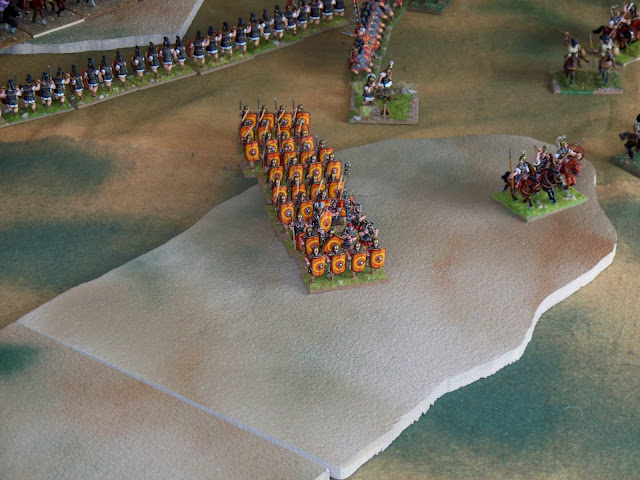Last Saturday, we had a Parthian vs. Roman battle using 28mm figures and modified DBA rules. DBA is a popular game here in the US, and there are many tournaments around the country. We are not tournament gamers (I used to be), so we try to have interesting games that are a little more than just lining up each army and crashing into each other. Present for the game was Al (the host), Bob, Ken, Mike, Bill, and I (Dave).
The battlefield that the Parthian and Romans fought over was mostly arid steppe or desert, without much in the way of terrain. Our battlefield had a few hills (made with ½ inch dense Styrofoam that was spray painted) placed on a felt mat that was also spray painted. The table was 8’x5,’ played in Al’s eat-in kitchen, at his home in Belvedere IL.
The Romans entered the board from one end in a march column of 4 Legions with light infantry and cavalry support, and some Scorpion bolt shooters (ancient artillery). The Parthians came on random locations of the table in 3 commands, the first two coming on behind the Roman right rear flank.
The Romans decided when the game began that they would halt in place and wait to see where the Parthians would appear. This was a fortunate decision, as they were able to react to the 2 Parthian commands in their rear before being strung out and away from a table edge. (NOTE: Unlike real battles, table edges in miniature battles help one to avoid being outflanked). The Roman right flank turned and soon, they formed a line against the Parthian cavalry. See the photo below:
The Roman right flank turns to face the Parthians. (Click on photo to enlarge)
The Roman light infantry archers engaged the Parthian light horse in an archery contest (unlike the DBA rules, we allow light troops to use missile fire; however we haven’t completely worked out how the missile fire effects should work). The Roman light infantry are in the foreground in the photo below. The Roman Legionaries with green and blue shields are behind.
The next picture below shows an overhead shot of the Roman right flank just before the Parthian light horse hit the archers. The Roman Legion in column in the right rear of the photo with red shields was deploying to eventually form a line perpendicular to the first, to face the flank where the 3rd Parthian command was expected to appear (it did, but not until turn 6).
Below is another shot of the Legion with red shields.
There are no more pictures of this battle, since your author’s camera battery went dead, and our host Al wouldn’t let me use the batteries from the remote control. In summary, the Parthians pushed the Roman right flank back and decimated the light infantry on that side. The Parthians in the center harassed the Legions until they pressed forward, forcing the light horse to mostly flee. The Parthian heavy cataphract cavalry moved forward to counter, and began overrunning some of the Legionaries. The 3rd Parthian command arrived on the scene and pressed unsuccessfully against the Roman left (the Roman line was in an L shape). The game was called when exhaustion set in on both sides with no clear victor.
We are currently discussing how we will re-work some of the rules for the next time, though the game and scenario itself seemed somewhat balanced. The beautifully painted figures are by Al (the Romans) and Bob (the Parthians).



